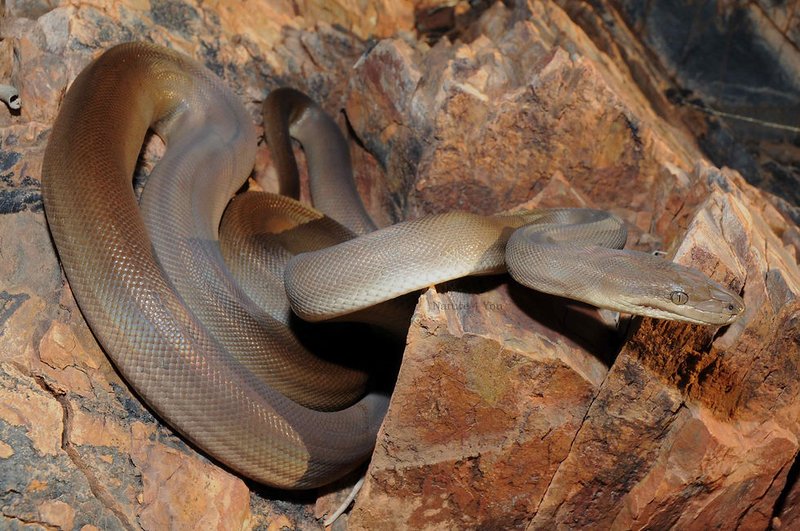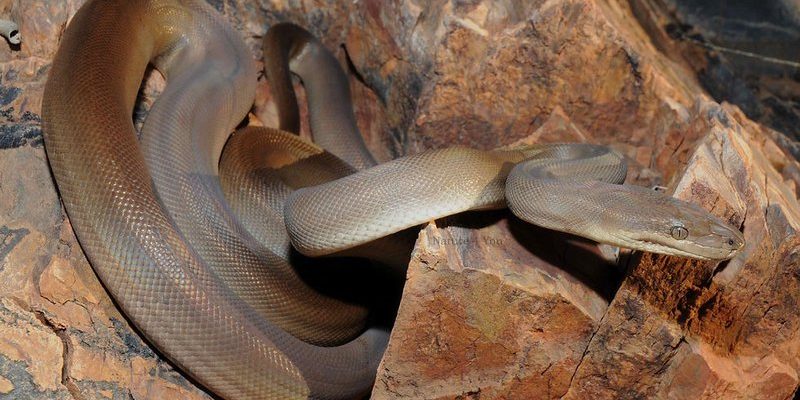
The Olive Python stands out with its stunning coloration and unique body structure. Typically, these snakes are characterized by a base color of olive green accented with darker blotches that help it blend into the foliage. You might be amazed to know that their coloration can vary significantly depending on their specific habitat. In certain regions, they might appear almost golden, while in others, they show a deeper green hue. This variety is part of what makes them so intriguing!
In terms of size, an adult Olive Python can reach lengths ranging from 6 to 10 feet. Isn’t that impressive? Their bodies are robust and muscular, designed for constricting their prey effectively. Their heads are relatively large compared to their bodies, which aids in grasping and swallowing large meals. If you ever get the chance to see one, you’ll notice those piercing yellow or white eyes, which make them look strikingly wise.
Habitat and Distribution
Olive Pythons are primarily found throughout northern and central Australia, as well as in parts of New Guinea and the islands of the Lesser Sundas. They tend to prefer habitats that offer plenty of cover, such as forests, woodlands, and scrublands. But here’s the kicker: Olive Pythons are also quite adaptable. They can thrive in both wet and dry environments, which broadens their range significantly.
This adaptability doesn’t just end at their habitat. When we look at their distribution, it’s fascinating to see how these snakes have carved out niches in various ecosystems. Whether they’re sunbathing on a rocky ledge or hunting in dense undergrowth, Olive Pythons know how to make the most of their surroundings. They often seek shelter in hollow trees or rock crevices, creating cozy hideouts where they can rest and digest.
Diet and Hunting Behavior
The Olive Python is a carnivore, primarily preying on small mammals, birds, and reptiles. Picture a stealthy predator gliding through the underbrush, using its keen senses to detect movement. These snakes are constrictors, meaning they wrap around their prey and squeeze until it can no longer breathe. This method may sound brutal, but it’s how they survive in the wild.
When hunting, Olive Pythons often exhibit remarkable patience. You might wonder what that looks like. Imagine the snake laying in wait for hours, perfectly still, until an unsuspecting animal wanders too close. Once they strike, their powerful muscles can overpower prey much larger than their heads, thanks to their ability to unhinge their jaws. After a successful hunt, they can go days or even weeks without food, depending on the size of their meal.
| Feature | Details |
| Length | 6 to 10 feet |
| Color | Olive green with dark blotches |
| Habitat | Woodlands, grasslands, rocky areas |
| Diet | Small mammals, birds, reptiles |
| Lifespan | Up to 20 years in captivity |
Behavior and Social Structure
When we observe the behavior of Olive Pythons, we notice that they are primarily solitary creatures. Unlike some snake species that can be social, these pythons prefer their own company. You might be surprised to learn, though, that during the breeding season, males can become quite competitive. They engage in a fascinating display of dominance by wrestling with one another. It’s like watching a tug-of-war in slow motion!
In terms of nighttime activity, Olive Pythons are typically nocturnal. This means they are most active after the sun goes down. You might be wondering why they prefer the night. Well, hunting at night allows them to avoid the heat of the day and increases their chance of finding prey that is also active during those hours. Imagine how exciting it must be for them to navigate their world under the cover of darkness!
Conservation Status
Currently, Olive Pythons are classified as a species of Least Concern by the International Union for Conservation of Nature (IUCN). This means they’re not facing immediate threats to their survival. However, like many wildlife species, they can be impacted by habitat destruction and climate change. It’s crucial that we raise awareness about these issues so we can protect their natural environments.
Conservation programs are in place to monitor their populations and ensure their habitats remain intact. You might find it encouraging to know that many people are passionate about protecting these incredible snakes and their ecosystems. By supporting conservation efforts, you’re helping to keep the Olive Python thriving for future generations.
Mythology and Cultural Significance
Across various cultures, snakes like the Olive Python often carry rich symbolism. In Indigenous Australian mythology, snakes are sometimes viewed as totems or spirit beings. They represent wisdom and are often associated with creation stories. This fascinating intersection of nature and culture gives us a deeper appreciation for the Olive Python and its role in the human experience.
You might also stumble across myths and legends that depict snakes as cunning or wise creatures. The Olive Python’s ability to hunt and survive in diverse environments has made it a subject of admiration and fascination. It’s incredible how a creature like this has inspired stories and beliefs over generations, weaving its way into the cultural fabric of the regions it inhabits.
Keep an Olive Python as a Pet
For those enchanted by the Olive Python, it’s not uncommon to consider keeping one as a pet. Before diving into this journey, however, it’s essential to conduct thorough research. These snakes can be demanding pets, needing adequate space, temperature regulation, and a proper diet. Think of it like adopting a puppy but with more specific needs!
Set up an appropriate habitat that mimics their natural environment. You’ll need a spacious enclosure with climbing branches, hiding spots, and a temperature gradient for basking and cooling. Curious enthusiasts often find joy in maintaining these setups, as it allows them to create a small slice of the Olive Python’s world right in their homes.
FAQ
What is the lifespan of an Olive Python in captivity?
In captivity, Olive Pythons can live for up to 20 years, sometimes even longer with proper care. This longevity is a significant factor to consider when thinking about keeping one as a pet. Providing a healthy diet, suitable habitat, and regular veterinary check-ups can help ensure they thrive for many years.
Are Olive Pythons dangerous to humans?
Olive Pythons are not considered dangerous to humans. They are generally non-aggressive and prefer to avoid confrontation. If threatened, they might bite, but they would much rather retreat than engage. Understanding their behavior helps in appreciating these creatures without fear.
How do Olive Pythons reproduce?
Olive Pythons are oviparous, meaning they lay eggs. After mating, a female will lay around 10 to 30 eggs, depending on her size and age. She often coils around her eggs to keep them warm until they hatch, which typically takes about 60 to 70 days.
What do Olive Pythons eat in the wild?
In the wild, Olive Pythons primarily feed on small mammals, birds, and occasionally reptiles. Their diet can vary based on what is available in their environment. This adaptability helps them survive in various habitats, from wooded areas to rocky terrains.
Can Olive Pythons change color?
While Olive Pythons don’t change color like some chameleons, their coloration can vary depending on their habitat. Factors such as light exposure and environment can influence their appearance, allowing them to better blend into their surroundings.
What do Olive Pythons need for a proper habitat?
Providing a suitable habitat for an Olive Python is crucial. They need a spacious enclosure with climbing structures, hiding spots, and a temperature gradient to regulate their body temperature. It’s important to research the requirements to create a comfortable environment for them.
Are Olive Pythons active during the day or night?
Olive Pythons are primarily nocturnal, meaning they are most active at night. This behavior allows them to hunt when their prey is also active, avoiding the heat of the day and increasing their chances of a successful hunt.
What is their primary method of hunting?
Olive Pythons are constrictors, meaning they use their muscular bodies to wrap around their prey and suffocate them. They are known for their patience, often waiting for hours or even days to strike at the perfect moment.
How can I support Olive Python conservation?
Supporting conservation efforts can include volunteering for local wildlife organizations, donating to habitat preservation projects, or raising awareness about the threats these snakes face. Every bit helps in ensuring that Olive Pythons and their habitats are protected for the future.
Are there any myths about Olive Pythons?
Yes, like many snakes, Olive Pythons are often surrounded by myths. In some cultures, they are revered as wise and powerful creatures, symbolizing knowledge and strength. These myths reflect the deep connection humans have had with snakes through history.
What are the key differences between Olive Pythons and other python species?
Olive Pythons are distinguished by their coloration and size. Compared to other species, they are typically more slender and display unique olive green markings. Additionally, their habitats and dietary preferences may differ based on the species in question, adding to their uniqueness as a python species.

